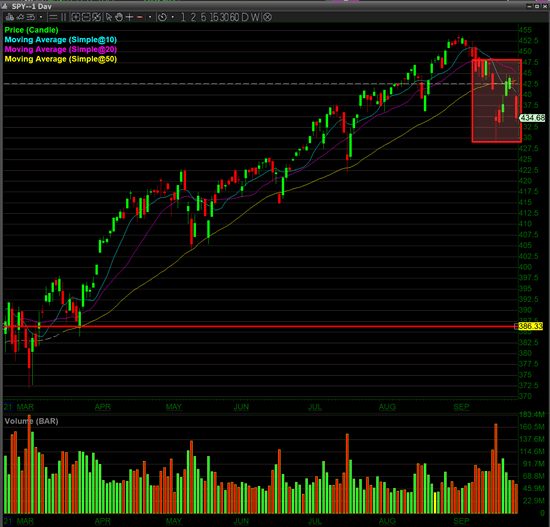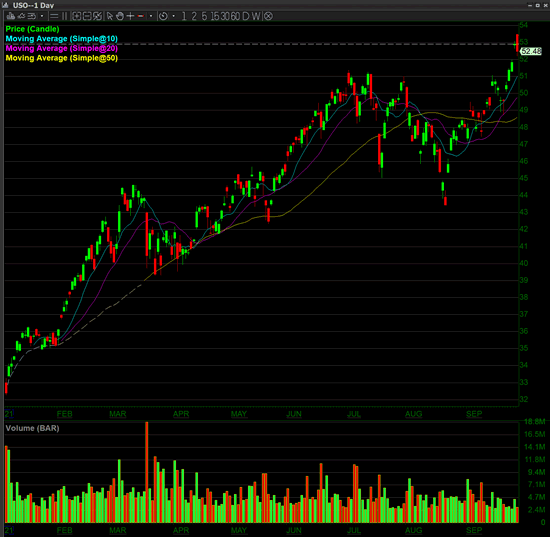U.S. stock markets have been a roller coaster, just as they were expected to be, this September. The main cause of this up and down action has been due to the ongoing debt ceiling crisis. (Franck, 2021) There have been a few other major uncertainties which we will cover shortly. All of these problems will need to be resolved or at least addressed in the coming month of October. We have mentioned these looming problems many times over the past few months, but until they begin to get in the new cycle they rarely start to affect the markets.
 (Chart 1) This intraday chart of $SPY shows the roller coaster ride of the week.
(Chart 1) This intraday chart of $SPY shows the roller coaster ride of the week.

This bearish pattern on the $SPY added to the impending news catalysts explained below; which is setting the stage for a technical and fundamental sell off. The red rectangle in the image above is the last week and a half, while the red horizontal line is the next key support level that the markets can fall to if the debt crisis is not handled expeditiously.
The Debt Ceiling Crisis
First, let’s give some background to this very predictable story. The U.S. is the most politically polarized it has been in generations. Two years ago in 2019, a debt ceiling limit waiver was passed, but this debt ceiling limit expired without being renewed in July 2021. A highly polarized Congress was unable to pass an emergency extension and/or stopgap funding to avoid a default. Now, the U.S. federal government has been operating on borrowed time since that point. On October 18th, the U.S. Treasury will run out of funding and have to shut down the federal government’s nonessential services.
The U.S. federal government shutting down is nothing new as these shutdowns have happened many times in the past. What would be a problem is if the U.S. federal government defaults on its debt, as that has never happened in the past. In 2011, the U.S. credit rating was dropped from AAA to AA (BBC, 2011). A default would be like an earthquake to the entire financial system; as U.S. treasury bonds are used to collateralize much of everything.
Earlier this week, the House of Representatives which is largely controlled by Democrats passed a stopgap measure; therefore, the markets were up. On September 27th, the Senate did not pass that stopgap measure and said they would be blocking anything that did not address their concerns. Therefore, the markets lost all the previous gains and are now down. This kind of political bickering creates the roller coaster-like action that we are seeing in the financial markets (see Chart 1).
The Fed Governors Active Trading Issue
Two Fed governors filed their resignation on September 27th; both of whom were involved in an active trading incident. They were found trading and investing in some of the companies of which the Fed was purchasing assets. Fed Governor Kaplan from Texas stated, “During my tenure, I have adhered to all Federal Reserve ethical standards and policies. My securities investing activities and disclosures met bank compliance rules and standards.” (Cox, 2021)
How this affects the market is that these two Fed governors have been a known quantity for years and now they will both have to be replaced by unknown quantities. Having two new Fed governors at this critical time adds a huge amount of uncertainty into the markets when there are already many variabilities. We should also note that Federal Reserve Chairman Powell is up for reappointment by President Biden, but many members of Congress will be against this. Democratic Senator Elizabeth Warren fears that he is a “dangerous man” as he has reduced the banking stress test required and has been aggressive in adding assets to the Fed balance sheet. This has been a major factor as to why markets have done well under Fed Chairman Powell. (Guida, 2021)
Energy Costs, Supply Chain Problems, and Inflation
Energy costs are skyrocketing because of a combination of factors. Oil is now at about $74 a barrel which is a 3 year high. (Hodari, 2021) At these prices, the cost of oil starts to affect everything and has a negative correlation on the markets since the economy needs oil to get to where it needs to go. The recent hurricane in the Gulf of Mexico caused refinery interruptions which are now being reflected in higher oil prices. World wide demand has increased as countries reopen post-pandemic. Seasonally, the winter in the northern hemisphere also causes increased demand as people need to heat their homes for the season.
Inflation also seems to be here to stay as suspected. (Cox, 2021)
What all of this brings us is a perfect storm for the financial markets at a time when markets are statistically bearish.
Let’s recap briefly. Here are the contributing factors to a potential market correction and/or selloff.
1.) Possible Federal shutdown.
2.) Congress needs to resolve the debt ceiling issue while still being polarized. (Oct 18th)
3.) Two Federal Reserve Bank governors resign over trading securities that the Federal was purchasing.
4.) Federal Reserve Bank chairman Jerome Powell is up for reappointment and many are critical of his track record as being too lax on regulatory and bank solvency issues.
5.) Oil is at a three-year high and is now above a price where it starts to have a negative correlation to the financial markets.
6.) Inflation concerns continue. Inflation may be here to stay for a while. The federal reserve and the Biden administration both previously stated that inflation was transitory.
7.) September and October are statistically the most bearish months of the year.
There are plenty of reasons why the volatility should continue, at least, until the end of October. Be cautious and trade well.
References
BBC. (2011, August 6). US loses AAA credit rating AFTER S&P downgrade. BBC News. Retrieved September 28, 2021, from https://www.bbc.com/news/world-us-canada-14428930.
Cox, J. (2021, September 27). Dallas fed President Kaplan to retire early on Oct. 8, Citing trading Disclosure ‘distraction’. CNBC. Retrieved September 27, 2021, from https://www.cnbc.com/2021/09/27/dallas-fed-president-kaplan-to-retire-early-on-oct-8-citing-trading-disclosure-distraction.html.
Cox, J. (2021, September 27). Fed chair Powell to WARN Congress that inflation pressures could last longer than expected. CNBC. Retrieved September 28, 2021, from https://www.cnbc.com/2021/09/27/fed-chair-powell-to-warn-congress-that-inflation-pressures-could-last-longer-than-expected.html.
Franck, T. (2021, September 28). Congress must raise debt limit by oct. 18, Treasury SECRETARY Yellen warns in new letter as DEFAULT LOOMS. CNBC. Retrieved September 28, 2021, from https://www.cnbc.com/2021/09/28/congress-must-raise-the-debt-limit-by-oct-18-yellen-warns.html.
Guida, V. (2021, September 28). ‘A dangerous man’: WARREN opposes reappointment of Fed’s Powell. POLITICO. Retrieved September 28, 2021, from https://www.politico.com/news/2021/09/28/warren-fed-powell-reappointment-514520.
Hodari, D. (2021, September 28). Investors See Natural-Gas Crunch Spilling Into Crude Market, Lifting Oil Prices. The Wall Street Journal. Retrieved September 28, 2021, from https://www.wsj.com/articles/oil-price-hits-three-year-high-as-natural-gas-crunch-spills-into-crude-market-11632823708.
What’s New from DAS
While we didn’t release any production updates during the month of September, we do plan on releasing some significant updates during October. We are currently beta testing version 5.6.4.15 which is available for all to test. If you wish to become a beta tester, you will need to fill out the contact form on our website and include the firm/broker you’re trading with as well as your login ID.
Please be sure to install the latest version of the DAS Trader Pro platform. You can do this very easily from DAS by clicking Tools > Auto Upgrade. You can learn more about the Auto Upgrade feature in our Knowledge Base.
Watch our Streams on YouTube
You can view the most recent live stream here as well as all of our live streams from this link.
If you have any ideas for anything you want to see on our live stream, please send us an email: newsletter@dastrader.com.
Get Ready for Our Next Video Series
Our next video series, “Patterns of Technical Day Trading”. This series will start being relesed the first week of November. Be sure to subscribe to our YouTube channel to get notified when the videos become available.
Join Mike DiGioia as he covers different types of trading styles and strategies, so be sure to follow us on YouTube, as well as our other social media platforms: @dastrader.




